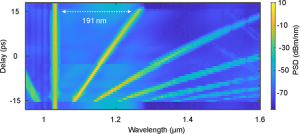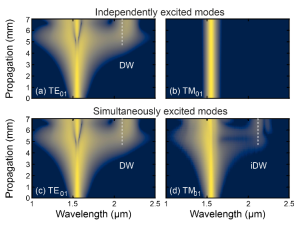Light Conversion in Waveguides
In nonlinear waveguides, laser light can be converted nonlinearly with respect to its spectral and spatial composition. In four-wave mixing (FWM) the spectral or spatial distribution of the laser light is changed by a nonlinear medium. In single-mode waveguides, i.e., those that only support a transverse mode, very broadband spectra - so-called supercontinua - can be generated using FWM with ultrashort laser pulses of around 100 fs pulse duration. In addition, longer pulses of around 1 ps pulse duration can be used to build so-called optical parametric oscillators (OPOs), which can efficiently convert laser light of one frequency into another frequency. In multi-mode waveguides, the energy of the laser light can be converted in a nonlinear way, for example from one transverse mode to another.
In multi-mode waveguides, pulses in the different modes can influence each other and thus generate spectral components that would not occur if the modes were excited separately. In particular, the spectral composition of a second mode can be changed during supercontinuum generation in one mode.



